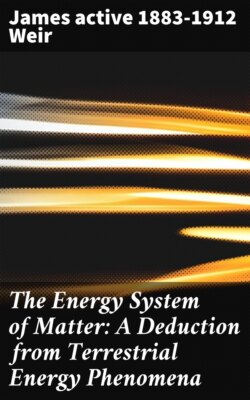Читать книгу The Energy System of Matter: A Deduction from Terrestrial Energy Phenomena - active 1883-1912 James Weir - Страница 11
На сайте Литреса книга снята с продажи.
5. Limits of Rotational Energy. Disruptional Phenomena
ОглавлениеTable of Contents
It is clear that the material at different parts of the rotating spheroid will be energised to varying degrees. Since the linear velocity of the material in the equatorial regions of the spheroid is greater than that of the material about the poles, the energy of motion of the former will exceed that of the latter, the difference becoming greater as the mass is increasingly energised and assumes more and more the discoidal form.
The question now arises as to how far this process of energising the material mass may be carried. What are its limits? The capacity of the rotating body for energy clearly depends on the amount of work which may be spent on its material in distorting it against the influence of the gravitative attraction. The amount is again dependent on the strength of this attraction. But the value of the gravitative attraction or gravitation field is, by the law of gravitation, in direct proportion to the quantity of material or matter present, and hence the capacity of the body for energy depends on its mass or on the quantity of matter which composes it.
Now if energy be impressed on this mass beyond its capacity a new order of phenomena appears. Distortion will be followed by disruption and disintegration. By the action of the disruptive forces a portion of the primary material will be projected into space as a planetary body. The manner of formation of such a secondary body is perhaps best illustrated by reference to the commonplace yet beautiful and suggestive phenomenon of the separation of a drop of water or other viscous fluid under the action of gravitation. In this process, during the first downward movement of the drop, it is united to its source by a portion of attenuated material which is finally ruptured, one part moving downwards and being embodied in the drop whilst the remainder springs upwards towards the source. In the process of formation of the planetary body we are confronted with an order of phenomena of somewhat the same nature. The planetary orb which is hurled into space is formed in a manner similar to the drop of viscous fluid, and under the action of forces of the same general nature. One of these forces is the bond of gravitative attraction between planet and primary which is never severed, and when complete separation of the two masses finally occurs, the incessant combination of this force with the tangential force of disruption acting on the planet will compel it into a fixed orbit, which it will pursue around the central axis. When all material links have thus been severed, the two bodies will then be absolutely separate masses in space. The term "separate" is here used in its most rigid and absolute sense. No material connection of any kind whatever exists, either directly or indirectly, between the two masses. Each one is completely isolated from the other by interplanetary space, and in reality, so far as material connection is concerned, each one might be the sole occupant of that space. This conception of separate masses in space is of great importance to the author's scheme, but, at the same time, the condition is one which cannot be illustrated by any terrestrial experimental contrivance. It will be obvious that such a device, as might naturally be conceived, of isolating two bodies by placing them in an exhausted vessel or vacuous space, by no means complies with the full conditions of true separation portrayed above, because some material connection must always exist between the enclosed bodies and the containing vessel. This aspect is more fully treated later (§ 30). The condition of truly separate masses is, in fact, purely a celestial one. No means whatever are existent whereby such a condition may be faithfully reproduced in a terrestrial environment.
In their separate condition the primary and planetary mass will each possess a definite and unvarying amount of energy. It is to be noted also, that since the original mass of the primary body has been diminished by the mass of the planet cast off, the capacity for energy of the primary will now be diminished in a corresponding degree. Any further increment of energy to the primary in any form has now, however, no direct influence on the energy of the planet, which must maintain its position of complete isolation in its orbit. But although thus separate and distinct from the primal mass in every material respect, the planet is ever linked to it by the invisible bond of gravitation, and every movement made by the planet in approaching or receding from the primary is made in the field or influence of this attraction. In accordance, therefore, with the general principle already enunciated (§ 4), these actions or movements of the energised planetary mass, being made in the field of the incepting gravitative influence, will be accompanied by transformations, and thus the energy of the planet, although unvarying in its totality, may vary in its form or distribution with the inward or outward movement of the planet in its orbital path. As the planet recedes from the primary it gains energy of position, but this gain is obtained solely at the expense, and by the direct transformation of its own orbital energy of motion. Its velocity in its orbit must, therefore, decrease as it recedes from the central axis of the system, and increase as it approaches that axis. Thus from energy considerations alone it is clear that, if the planetary orbit is not precisely circular, the velocity of the planet must vary at different points of its path.
